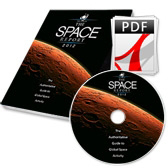Report from Headquarters
The Space Report 2012 Is Now Available for Purchase Online
Written by: developer

In May, the Space Foundation’s Washington, D.C., office staff briefed White House staff, NASA’s legislative affairs office and congressional staff on the Space Foundation publication The Space Report 2012: The Authoritative Guide to Global Space Activity. This annual publication is the definitive overview of the global space industry and serves as a valuable resource for government and business leaders, educators, financial analysts, students and space-related businesses. The 2012 book details how the global space economy grew to $289.77 billion in 2011, reflecting a surprisingly robust single-year expansion of 12.2 percent and five-year growth of 41 percent* in a global economy that has been suppressed in many other sectors.
About the Book
The 164-page book contains worldwide space facts and figures and is illustrated with photographs, charts and graphs. PDF and CD-ROM versions include hyperlinks to the companies, organizations, reports and references mentioned in the text.
The book is divided into five sections: Space Products and Services, the Space Economy, Space Infrastructure, Workforce and Education and an Outlook for the future. Within those chapters are myriad examples of the benefits of space exploration and utilization, the challenges facing the space sector, the opportunities for future growth and the major factors that shape the industry. In addition, The Space Report includes an overview of each sector, easy-to-understand definitions and up-to-date information on space infrastructure, facilities, launches and programs.
Section 1 — Space Products and Services
This section includes information on:
- How a space spinoff gets created, such as how a water purification system originally developed for use on the Space Shuttle has been adapted to provide clean drinking water for hundreds of villages in under-developed parts of the world
- How space products and services are used
- Products and services about space, in addition to ones that come from space activity, such as NASA’s Eyes on the Solar System tool that allows people to explore the universe from their home computers — accessing data collected by NASA spacecraft
- Emerging technologies, such as small, inexpensive satellites that can be used for specific missions
- Measuring the impact of spinoffs
Section 2 — The Space Economy
This section, considered the definitive global analysis of the entire space economy, covers a wide range of factors contributing to the $289.77 global space economy and the 12.2 percent increase over 2010. It details:
- Commercials space products and services, which are the real drivers of growth, especially GPS devices and chipsets and direct-to-home (DTH) television
- Governmental space spending, which increased worldwide by 6 percent with significant variation among nations
- An overview of how the budget data were collected and compiled
- The outlook for investment data
- How commercial space companies’ stocks out-performed the marketplace in 2011
Section 3 –Space Infrastructure
This section looks at launch vehicles, space stations, satellites, ground stations, spaceports, observatories, robotic exploration stations and technology development. Highlights include:
- In 2011, there were 84 launches, an increase of 14 percent over 2010; Russia led with 31, China had 19 and the U.S. totaled 18, the first time that Chinese launches exceeded that of the United States
- At the end of 2011, there were an estimated 994 active satellites in orbit around the Earth
- Among the top 25 fixed satellite services operators by revenue, only one is based in the U.S.
Section 4 — Workforce and Education
This section explores workforce statistics and education trends that affect the ability to create a skilled workforce. There are chapters on U.S., European, Japanese and Korean space employment plus information on the entire global workforce. Key points include:
- The U.S. space workforce declined for the fourth year in a row, dropping 3 percent from 259,996 in 2009 to 252,315 in 2010 (the most recent year for which data is available); this was the second-lowest employment level recorded during the previous ten years; conversely, both Europe and Japan saw increases in their space workforces
- The U.S. military space workforce was 16,739 in 2011, a 6 percent increase from 2009; the Air Force workforce grew by 8 percent, while the Navy space workforce declined by 5 percent
- The chapter also looks at global space education, including an in-depth look at primary school math and science proficiency, quoting the newest — and slightly improved – numbers from U.S.-specific and worldwide exams.
Section 5 — Outlook
The book concludes with an Outlook section that, this year, focuses on four thematic areas reflecting important trends in space activity:
- Changes in the trajectory of human spaceflight
- National budget austerity that leads to programmatic uncertainty
- The maturing relationship between government and commercial space
- Increasingly prevalent and diverse partnership models
How to Purchase The Space Report 2012
The Space Report 2012 is available in print, on CD-ROM or as a downloadable PDF online at www.TheSpaceReport.org. Multi-user licenses for schools and businesses are available. The book is a “green” publication; the materials used in the processes for printing The Space Report 2012 have been certified as meeting the standards and requirements of the Forest Stewardship Council (FSC).
This article is part of Space Watch: June 2012 (Volume: 11, Issue: 6).
